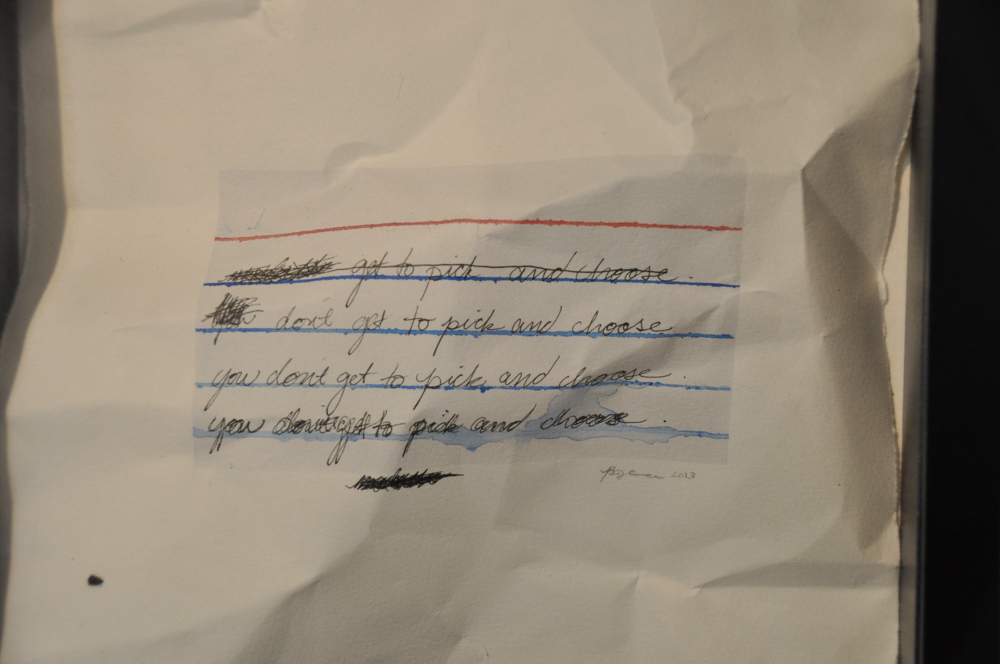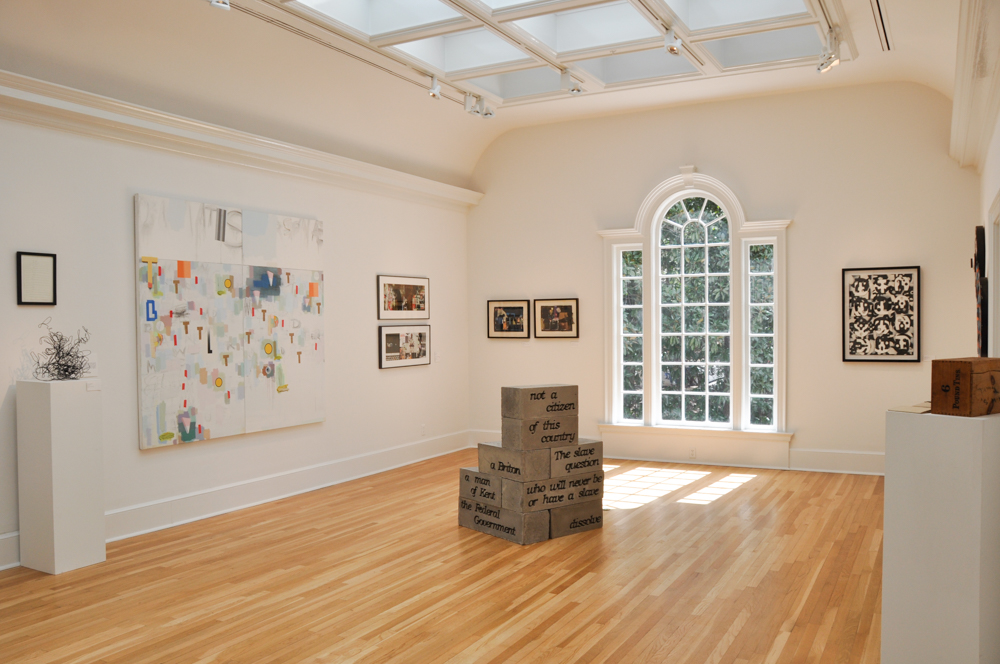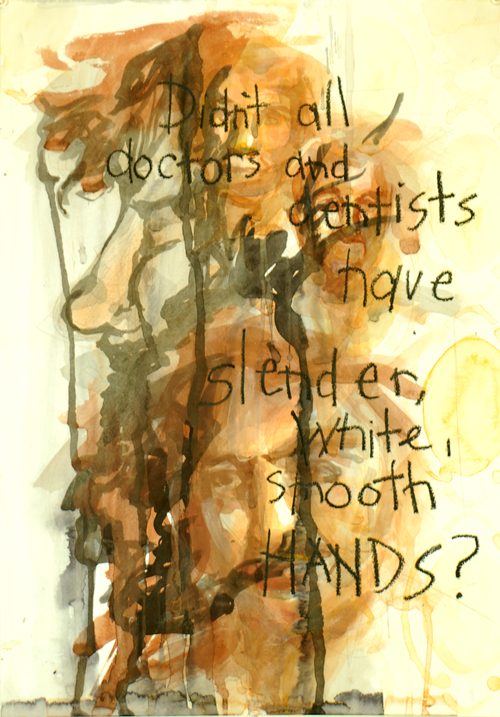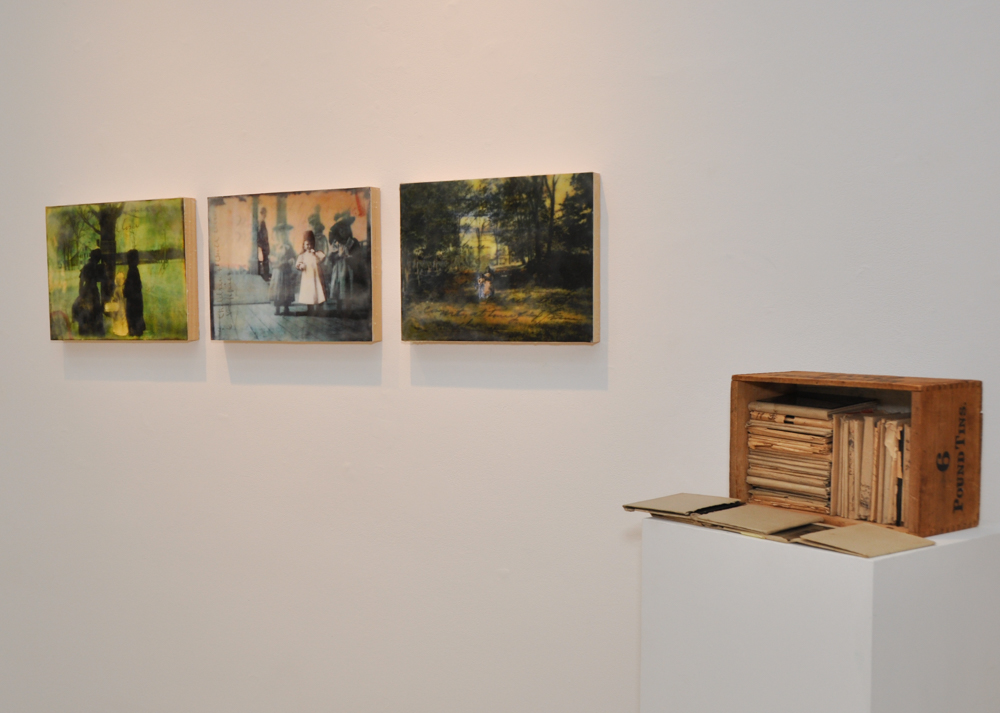One of the most untrue philosophic statements ever written is Ludwig Wittgenstein’s “The limits of my language mean the limits of my world,” if we regard “language” as words and their dictionary definitions. In practice, we interpret the world in a multitude of ways that elude ordinary spoken or written language. We create our world through purely visual symbols as much as verbal ones, and in ways that stretch the meanings of the words we use to describe that wordless act of creation. That space of interplay between written language and visual meaning is the subject of “Beyond Words,” a show curated by Hope Cohn for Swan Coach House Gallery, where it is on view through April 6. (A curator’s talk with several of the artists will take place tomorrow, March 17, from 3 to 5pm.)
Cohn begins the exhibition with a replica of a cuneiform tablet borrowed from the Carlos Museum at Emory. It represents the Sumerian writing system in which simplified pictures representing objects came to be related to the sound of the spoken words that signified those objects. This early, imperfect relationship between sound and written image is juxtaposed with Marcia R. Cohen’s provocative meditation on the relationship between visuality in written language and visuality in images, especially in relation to color. Cohen’s Out of the Blue series places drawings made with lapis lazuli and ash next to texts written in braille that describe the color blue. The framed objects present an extraordinary revelation: Sighted viewers can, of course, see the drawing and its rich color, and see the braille description that tries to evoke an experience of color that is only available to those with sight (and without color blindness). Since the text is framed behind glass, neither the sighted nor the blind can interpret it through touch, but sighted viewers with knowledge of the braille alphabet might be able to read the colorless embossed dots—which, considered purely as abstract configurations, are curiously reminiscent of the complex wedge patterns of cuneiform.

We are obviously in for a mind-stretching experience, as is indicated by the pairing of Bethany Collins’s pages of words repeated and blotted, or redacted with a solid charcoal rectangle, and Karen Tauches’s recycled roadside advertising signs in which the gaudy colors and ghastly typefaces are part of a communicative strategy that she turns to her own subversive purposes. We are looking at more types of meaning than meet the innocent eye, before we ever reach the main gallery.
That gallery is introduced by the tour de force of the show, a wall drawing by John Beadles in which text and cartoon images blend seamlessly into an epic work in which viewers will find it challenging to focus on any single element for more than a moment, since everything around it demands an equal share of attention. With visual and verbal quotations ranging from hieroglyphics of Egyptian gods to song lyrics from the 1970s, this ephemeral site-specific piece could easily yield hours of pleasure, and possible enlightenment.
Song lyrics from the present moment find their way into Christine Mi’s Snapchat-app parodies of art history posted on the other side of the wall from Beadles’s extravaganza. Inserting her own self-portrait photo into freely rendered versions of familiar paintings from The Death of Marat to self-portraits by Frida Kahlo, Mi turns memes into visual jokes meant to appeal to Snapchat users while potentially encoding further layers of meaning—layers that Cohn discerned with fascination, thus leading to her request for digital files to print for this exhibition.
The rest of the show embodies an amazing array of possible relationships between writing and visual imagery—almost everything except traditional calligraphy. However, writing as pure abstract fluidity finds expression in Sarah Nathaniel’s conventional drawing in which the word “line” is stretched out into unreadable extended lines of ink, and in wire wall sculptures and a pedestal piece in which a rude four-letter word gets the same treatment—one of the growing number of times in which “fuck” appears as part of the title of an artwork in a gallery that in earlier decades was notable as a sanctuary for reticent gentility.

The look of printed text considered as abstract form also appears in Craig Drennen’s painting Dramatis Personae, in which the list of characters from Shakespeare’s Timon of Athens provides the placement for shapes suggesting the letters “t,” “p,” and “o” superimposed on corresponding letters of the words written on the canvas, creating a dynamic composition. Esteban Patino’s seemingly abstract wall sculptures are actually composed of an alphabet-like set of symbols without meaning—but that, just as in cuneiform or braille, can take on meaning through a set of arbitrary decisions. There is a social context here that remains invisible until explained in a statement—Patino uses this system to explore with communities how meaning is constructed.

Jessica Caldas and Larry Walker are also concerned with how meaning is constructed in social contexts, but in very different ways. Caldas overlays images of abuse victims with the written words that so seldom express their situation adequately. Walker collages torn advertising texts to replicate the look of poster-laden walls, with key phrases used in the titles of the works—Have No Fear, for example, from the slogan “Have No Fear, Legal Help Is Here.”
Jason Francisco also incorporates a photograph of torn posters into a complex image in which the point is that the photograph has no obvious meaning. “A photograph,” he states in a wall label, “is neither a self-illustrating tale or self-explanatory picture.” The point is reinforced by another photograph that, at first glance, seems to be both: an image of two memorial plaques replacing two comparably sized paving stones on cobblestone street, each plaque bearing the name of a former occupant of the address who was killed during the Holocaust. (The plaques are part of the “Stumbling Stones” project by German artist Gunter Demnig.) A viewer unfamiliar with the history of the memorial plaques and unable to read German might well see only an attractive image.
Michael David Murphy approaches the relationship between photography and language from a completely opposite starting point, creating written narratives about the photographs he should have taken but did not, because of obstacles ranging from the absence of a camera to lack of courage to click the shutter. If, as Francisco writes, “a photograph is not merely the physical picture…but the mental picture that results from…language we ourselves generate in trying to deal with, cope with, account for the picture,” Murphy gives us language that copes with the failure to make the picture by describing the photograph that should have come into being.

A photograph, then, is a piece of evidence of history that is far from self-interpreting, and Lesley Ann Price has created composite images that deal with this reality. She came into possession of a quantity of glass negatives dated 1899 that she eventually discovered represented three generations of a New Hampshire family active in the expanding telephone industry—but this required considerable research based on textual and visual clues. The wrapped glass negatives presented as a pedestal-based installation, and the encaustic-coated digitally manipulated images derived from the negatives, evoke an atmosphere rather than telling the history she recounts in her wall text.
Likewise, history provides the potent phrases that Mary Stuart Hall inscribes in stacked blocks of cast concrete—such words as “not a citizen of this country,” “a man of Kent,” “who will never be or have a slave,” and other peculiarly relevant fragments are quoted from a letter written in 1847 by one of her great grandfathers to his wife’s nephew back home in England. The letter describes the immigrant experience and the political situation in the United States, and from it Hall has selected the words that she finds most resonant and has cast them in a material that bears the literal weight that the words themselves bear only metaphorically.
After these thick encounters with the burden of history, it comes as a relief to encounter the playfulness of Ruth Laxson’s drawings with meandering lines of text handwritten around them, expressing opinions that range from the observation in Damsel Fly “so do we go by” (like the insect) to Some Glad Morning’s “I have nothing to say and I’m saying it.” John Tindel provides a different sense of relief in his complex but endearing combination of images with downhome phrases such as the phrase from a hymn that also provides the painting’s title, What Wondrous Love Is This, and in the Southern Dialect Series, small works consisting only of blockily lettered transcriptions of characteristic Southern ways of speaking.
There is a further surprise in the show, the inclusion as visual art of Lauri Stallings’s dance troupe glo under the title Erasing the Rules. These iterations of movement within the space are scheduled to have two more occurrences: once on Saturday, March 17, during the curator’s conversation with several of the artists from 3 to 5pm, and once during the closing day of the exhibition, April 6.




